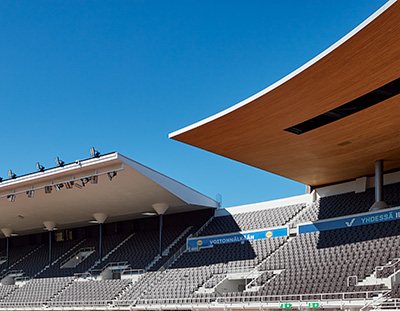CEO Tomi Norrby is leading Suomen Teollisuuskatot Oy, a family business founded in 1994, which has contracted almost a couple of million square meters of roof renovation and new building projects over two decades. Paroc stone wool has been the company’s insulation choice since the very beginning. – The cooperation with Paroc dates back to the days prior to the founding of our company. My father, Taisto Norrby, worked at Partek’s Industrial Roofs, and since he founded the company in 1994, we have completed most of the roofing projects with Paroc stone wool, Tomi Norrby explains.
The partnership has gone smoothly in both directions, and confidence in stone wool has not faltered over the decades. – We have seen many types of roofs along the way, and we think stone wool is simply the most effective roof insulation. It is resistant to moisture and dries within the structure, so there is no risk of mold in the roof, and the insulation retains its strength. The installability of stone wool is also in a class of its own. It adapts enormously well to the unevenness of the base structure, which makes the seams really tight.
Teollisuuskatot has specialized in large-scale industrial roof projects, where efficient logistics and work organization are paramount. The second cornerstone is challenging new building and renovation projects, such as the Helsinki Olympic Stadium. – The Olympic Stadium was an exceptional roofing project, as the stadium’s roof is a very visible part of Helsinki’s cityscape. The extra challenge factor was also the fact that it is an iconic sports sanctuary described as the most beautiful stadium in the world and an architecturally valuable building, Norrby explains.
Roof like an airplane wing
The roof project of the Olympic Stadium started for Teollisuuskatot in late spring 2018 and was completed in 2020. -The site was structurally challenging, as the profile of the stadium roof is of the shape of an airplane wing. The structure of the roof itself is simple, but all its surfaces are curved, so the radius and width of the roof were constantly changing. It posed extra work and challenge in terms of implementation. The roof of the Olympic Stadium is also not a traditional warm roof, but rather a cold canopy that is exposed to significant weather variations and wind loads. As we began to consider the wind loads on the roof, the client commissioned a prototype that we studied in a wind tunnel. After we got the results of the wind tunnel tests, we spent weeks making mooring plans to make sure the roof stays in place, Norrby says.
The roof area of the Olympic Stadium is 15,365 m2, so special attention also had to be paid to the selected materials. Stone wool was chosen as the roof insulation. -We used slightly harder stone wool in the structure in two 30 mm layers. In this way, we could make the insulation form nicely into the curved shapes of the roof. At the planning stage, we also had to take into account the fact that the insulation will undergo moisture fluctuations, in which case it must be able to become wet and dry freely within the structure so that it retains its strength despite the changes.
The most beautiful stadium in the world today and tomorrow
Teollisuuskatot is an innovative developer in its field, which uses Alkorplan’s PVC water roof in its roofing projects. It is in a class of its own for installation, according to Norrby, for fire safety and cost-effectiveness. -In the Olympic Stadium project, we added an impressive Clearcoat lacquer coating to the roof cover. That guarantees that the roof of the most beautiful stadium in the world will remain stylish for a long time to come, Norrby added.


